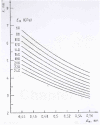Evaluation of Bond Strength of Pressed and Layered Veneering Ceramics to Nickel-Chromium Alloy
- PMID: 26535402
- PMCID: PMC4623836
Evaluation of Bond Strength of Pressed and Layered Veneering Ceramics to Nickel-Chromium Alloy
Abstract
Statement of the problem: The success of metal- ceramic- restorations (MCR) depends on the presence of strong bond between porcelain and metal substructure.
Purpose: The purpose of this study was to evaluate the effect of hot pressing technique on the bond strength of a metal-porcelain composite in comparison to layering technique.
Materials and method: Thirty Nickel-Chromium specimens were produced by two methods; conventional porcelain layering on metal and hot pressing (n=15). Bond strengths of all specimens were assessed by the means of three-point bending test according to ISO 9693: 1999 (E) instructions. The data were analyzed using Students t-test (p< 0.001).
Results: The mean ± SD bond strength of conventional and hot pressing technique was 48.29 ± 6.02 and 56.52 ± 4.97, respectively. Therefore, the conventional layering technique yielded significantly lower mean bond strength values than hot pressing technique (p< 0.001).
Conclusion: This study showed that it is possible to improve metal-porcelain bond strength significantly by applying an overpressure during porcelain firing.
Keywords: Bond; Layering porcelain; Metal; Pressable porcelain.
Figures
References
-
- De Backer H, Van Maele G, De Moor N, Van den Berghe L. Long-term results of short-span versus long-span fixed dental prostheses: an up to 20-year retrospective study. Int J Prosthodont. 2008; 21: 75–85. - PubMed
-
- Walton TR. An up to 15-year longitudinal study of 515 metal-ceramic FPDs: Part 1. Outcome. Int J Prosthodont. 2002; 15: 439–445. - PubMed
-
- Joias RM, Tango RN, Junho de Araujo JE, Junho de Araujo MA, Ferreira Anzaloni Saavedra Gde S, Paes-Junior TJ, et al. Shear bond strength of a ceramic to Co-Cr alloys. J Prosthet Dent. 2008; 99: 54–59. - PubMed
-
- Fischer J, Zbären C, Stawarczyk B, Hämmerle CH. The effect of thermal cycling on metal-ceramic bond strength. J Dent. 2009; 37: 549–553. - PubMed
-
- Bagby M, Marshall SJ, Marshall GW Jr. Metal ceramic compatibility: a review of the literature. J Prosthet Dent. 1990; 63: 21–25. - PubMed
LinkOut - more resources
Full Text Sources
Research Materials


